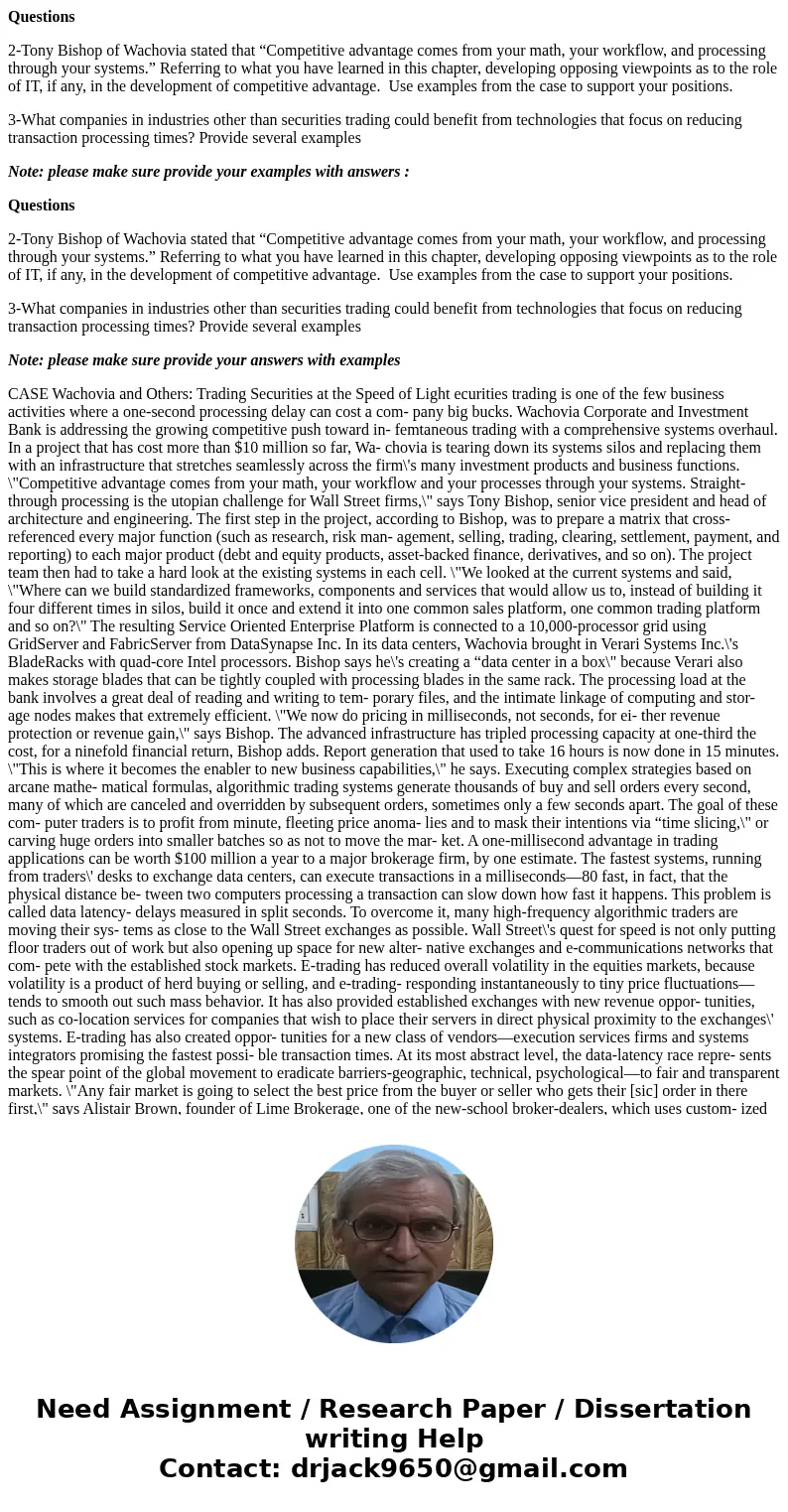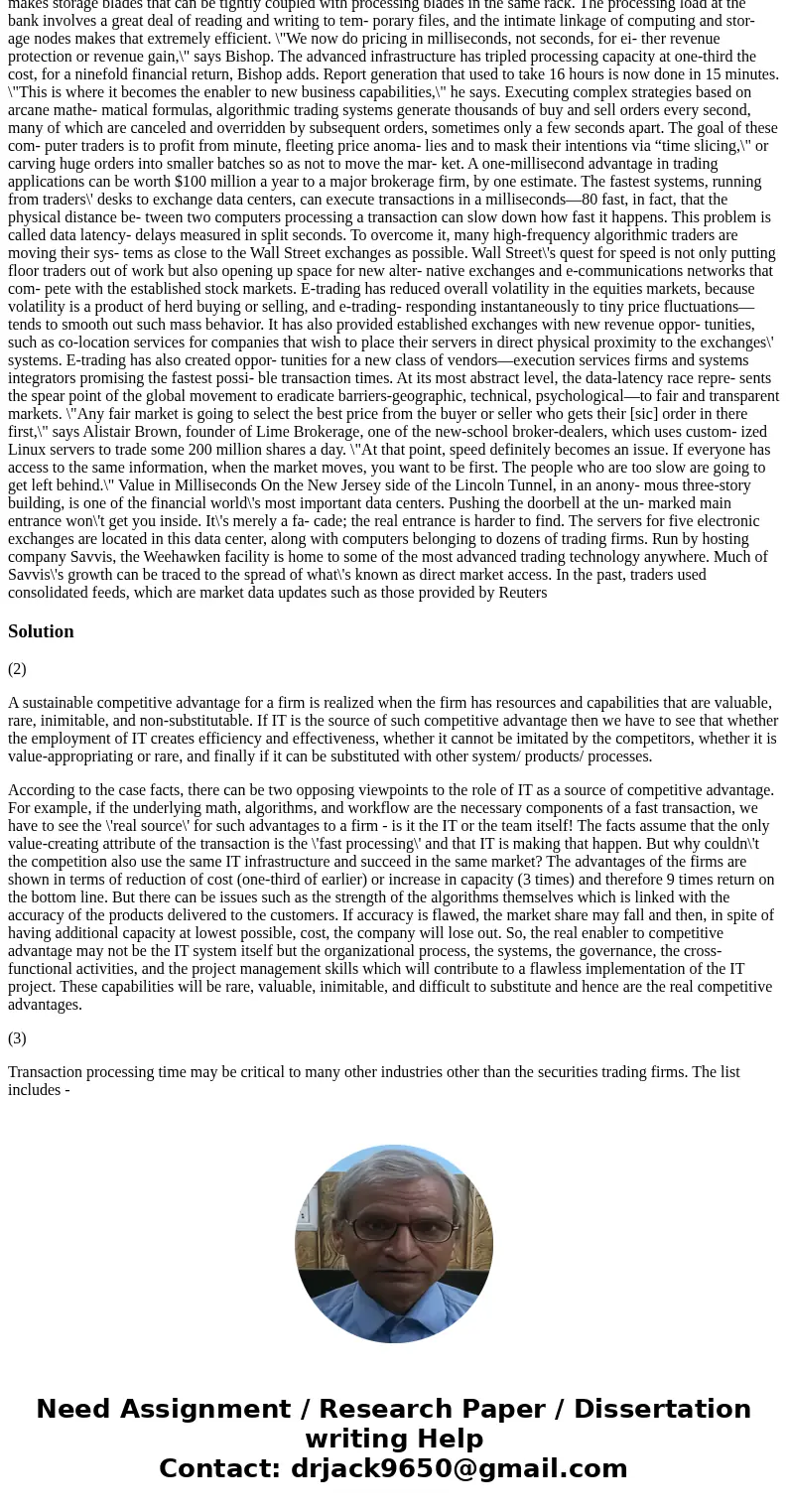Questions 2Tony Bishop of Wachovia stated that Competitive a
Questions
2-Tony Bishop of Wachovia stated that “Competitive advantage comes from your math, your workflow, and processing through your systems.” Referring to what you have learned in this chapter, developing opposing viewpoints as to the role of IT, if any, in the development of competitive advantage. Use examples from the case to support your positions.
3-What companies in industries other than securities trading could benefit from technologies that focus on reducing transaction processing times? Provide several examples
Note: please make sure provide your examples with answers :
Questions
2-Tony Bishop of Wachovia stated that “Competitive advantage comes from your math, your workflow, and processing through your systems.” Referring to what you have learned in this chapter, developing opposing viewpoints as to the role of IT, if any, in the development of competitive advantage. Use examples from the case to support your positions.
3-What companies in industries other than securities trading could benefit from technologies that focus on reducing transaction processing times? Provide several examples
Note: please make sure provide your answers with examples
CASE Wachovia and Others: Trading Securities at the Speed of Light ecurities trading is one of the few business activities where a one-second processing delay can cost a com- pany big bucks. Wachovia Corporate and Investment Bank is addressing the growing competitive push toward in- femtaneous trading with a comprehensive systems overhaul. In a project that has cost more than $10 million so far, Wa- chovia is tearing down its systems silos and replacing them with an infrastructure that stretches seamlessly across the firm\'s many investment products and business functions. \"Competitive advantage comes from your math, your workflow and your processes through your systems. Straight- through processing is the utopian challenge for Wall Street firms,\" says Tony Bishop, senior vice president and head of architecture and engineering. The first step in the project, according to Bishop, was to prepare a matrix that cross- referenced every major function (such as research, risk man- agement, selling, trading, clearing, settlement, payment, and reporting) to each major product (debt and equity products, asset-backed finance, derivatives, and so on). The project team then had to take a hard look at the existing systems in each cell. \"We looked at the current systems and said, \"Where can we build standardized frameworks, components and services that would allow us to, instead of building it four different times in silos, build it once and extend it into one common sales platform, one common trading platform and so on?\" The resulting Service Oriented Enterprise Platform is connected to a 10,000-processor grid using GridServer and FabricServer from DataSynapse Inc. In its data centers, Wachovia brought in Verari Systems Inc.\'s BladeRacks with quad-core Intel processors. Bishop says he\'s creating a “data center in a box\" because Verari also makes storage blades that can be tightly coupled with processing blades in the same rack. The processing load at the bank involves a great deal of reading and writing to tem- porary files, and the intimate linkage of computing and stor- age nodes makes that extremely efficient. \"We now do pricing in milliseconds, not seconds, for ei- ther revenue protection or revenue gain,\" says Bishop. The advanced infrastructure has tripled processing capacity at one-third the cost, for a ninefold financial return, Bishop adds. Report generation that used to take 16 hours is now done in 15 minutes. \"This is where it becomes the enabler to new business capabilities,\" he says. Executing complex strategies based on arcane mathe- matical formulas, algorithmic trading systems generate thousands of buy and sell orders every second, many of which are canceled and overridden by subsequent orders, sometimes only a few seconds apart. The goal of these com- puter traders is to profit from minute, fleeting price anoma- lies and to mask their intentions via “time slicing,\" or carving huge orders into smaller batches so as not to move the mar- ket. A one-millisecond advantage in trading applications can be worth $100 million a year to a major brokerage firm, by one estimate. The fastest systems, running from traders\' desks to exchange data centers, can execute transactions in a milliseconds—80 fast, in fact, that the physical distance be- tween two computers processing a transaction can slow down how fast it happens. This problem is called data latency- delays measured in split seconds. To overcome it, many high-frequency algorithmic traders are moving their sys- tems as close to the Wall Street exchanges as possible. Wall Street\'s quest for speed is not only putting floor traders out of work but also opening up space for new alter- native exchanges and e-communications networks that com- pete with the established stock markets. E-trading has reduced overall volatility in the equities markets, because volatility is a product of herd buying or selling, and e-trading- responding instantaneously to tiny price fluctuations— tends to smooth out such mass behavior. It has also provided established exchanges with new revenue oppor- tunities, such as co-location services for companies that wish to place their servers in direct physical proximity to the exchanges\' systems. E-trading has also created oppor- tunities for a new class of vendors—execution services firms and systems integrators promising the fastest possi- ble transaction times. At its most abstract level, the data-latency race repre- sents the spear point of the global movement to eradicate barriers-geographic, technical, psychological—to fair and transparent markets. \"Any fair market is going to select the best price from the buyer or seller who gets their [sic] order in there first,\" says Alistair Brown, founder of Lime Brokerage, one of the new-school broker-dealers, which uses custom- ized Linux servers to trade some 200 million shares a day. \"At that point, speed definitely becomes an issue. If everyone has access to the same information, when the market moves, you want to be first. The people who are too slow are going to get left behind.\" Value in Milliseconds On the New Jersey side of the Lincoln Tunnel, in an anony- mous three-story building, is one of the financial world\'s most important data centers. Pushing the doorbell at the un- marked main entrance won\'t get you inside. It\'s merely a fa- cade; the real entrance is harder to find. The servers for five electronic exchanges are located in this data center, along with computers belonging to dozens of trading firms. Run by hosting company Savvis, the Weehawken facility is home to some of the most advanced trading technology anywhere. Much of Savvis\'s growth can be traced to the spread of what\'s known as direct market access. In the past, traders used consolidated feeds, which are market data updates such as those provided by ReutersSolution
(2)
A sustainable competitive advantage for a firm is realized when the firm has resources and capabilities that are valuable, rare, inimitable, and non-substitutable. If IT is the source of such competitive advantage then we have to see that whether the employment of IT creates efficiency and effectiveness, whether it cannot be imitated by the competitors, whether it is value-appropriating or rare, and finally if it can be substituted with other system/ products/ processes.
According to the case facts, there can be two opposing viewpoints to the role of IT as a source of competitive advantage. For example, if the underlying math, algorithms, and workflow are the necessary components of a fast transaction, we have to see the \'real source\' for such advantages to a firm - is it the IT or the team itself! The facts assume that the only value-creating attribute of the transaction is the \'fast processing\' and that IT is making that happen. But why couldn\'t the competition also use the same IT infrastructure and succeed in the same market? The advantages of the firms are shown in terms of reduction of cost (one-third of earlier) or increase in capacity (3 times) and therefore 9 times return on the bottom line. But there can be issues such as the strength of the algorithms themselves which is linked with the accuracy of the products delivered to the customers. If accuracy is flawed, the market share may fall and then, in spite of having additional capacity at lowest possible, cost, the company will lose out. So, the real enabler to competitive advantage may not be the IT system itself but the organizational process, the systems, the governance, the cross-functional activities, and the project management skills which will contribute to a flawless implementation of the IT project. These capabilities will be rare, valuable, inimitable, and difficult to substitute and hence are the real competitive advantages.
(3)
Transaction processing time may be critical to many other industries other than the securities trading firms. The list includes -


 Homework Sourse
Homework Sourse